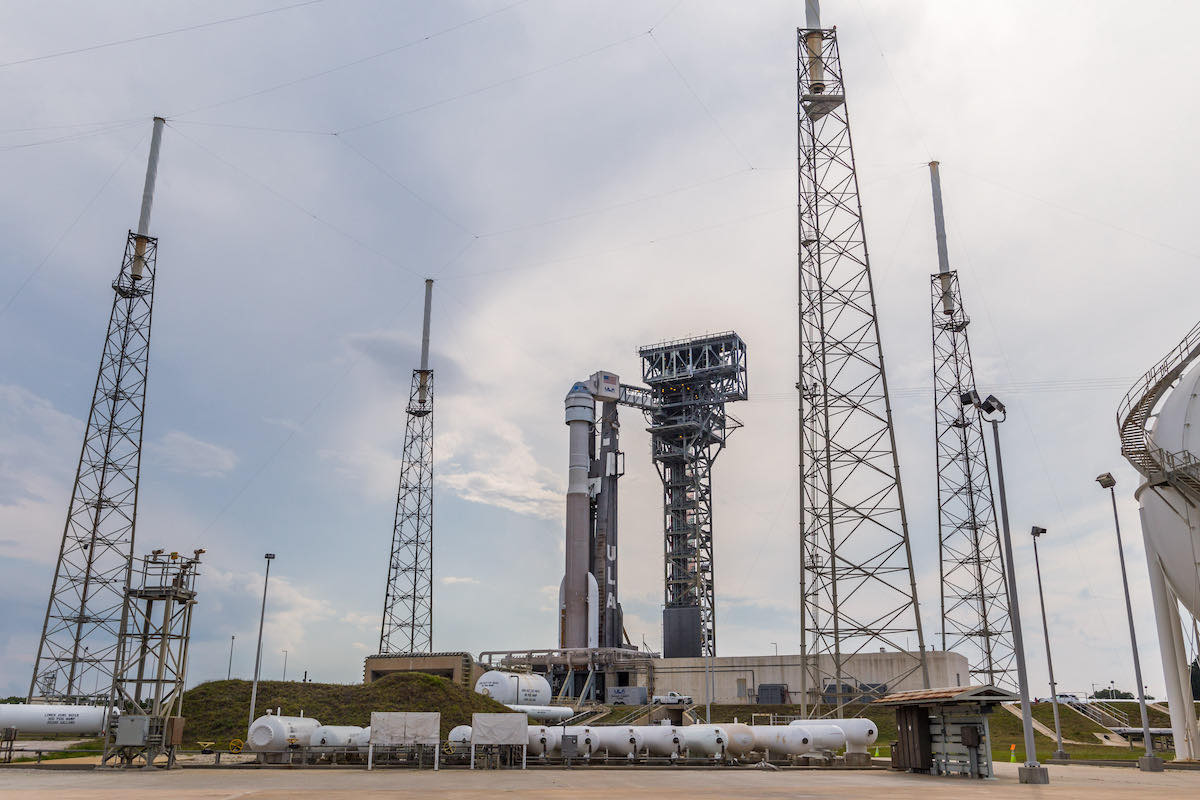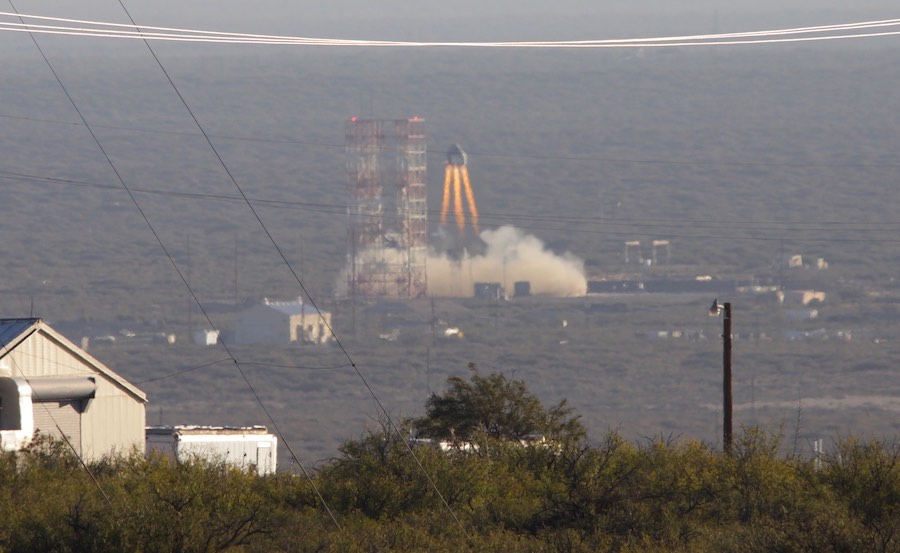
United Launch Alliance rolled an Atlas 5 rocket to its launch pad Wednesday at Cape Canaveral, moving into the starting position for a critical unpiloted demo flight of Boeing’s Starliner crew capsule. Unlike the first Starliner test flight, the spacecraft’s launch abort system will be armed during the climb to space Thursday.
Running years behind schedule, Boeing’s crew capsule is one of two spacecraft NASA selected in 2014 to transport astronauts to and from the International Space Station. The other capsule was SpaceX’s Dragon spacecraft, which has now launched seven times with people on-board.
Boeing officials hope the Starliner spacecraft’s second Orbital Flight Test, or OFT-2 mission, will clear the way for it to begin regular crew rotation service to the station.
The OFT-2 mission is set to launch from pad 41 at Cape Canaveral Space Force Station at 6:54:47 p.m. EDT (2254:47 GMT) Thursday, roughly the moment Earth’s rotation brings the launch pad under the flight path of the International Space Station.
The Atlas 5 will fire off the pad with 1.6 million pounds of thrust from its Russian-made RD-180 main engine and two solid rocket boosters supplied by Aerojet Rocketdyne. Steering northeast from the seaside launch complex, the Atlas 5 will surpass the speed of sound in 65 seconds, then shed its strap-on boosters at T+plus 2 minutes, 22 seconds.
The RD-180 engine, burning kerosene and liquid oxygen, will fire until T+plus 4 minutes, 29 seconds. The RD-180 will throttle back late in its four-and-a-half minute burn to limit acceleration loads on the Starliner to no more than 3.5 Gs, just as it will on future astronaut missions.

Six seconds after engine shutdown, the bronze first stage will separate from the Atlas 5’s Centaur upper stage to fall into the Atlantic Ocean, then a disposable aerodynamic cover will jettison from the nose cone of the Starliner capsule.
Two Aerojet Rocketdyne RL10 engines will ignite at T+plus 4 minutes, 45 seconds, to begin a seven-minute burn. A few seconds later, the Atlas 5 will jettison an aerodynamic skirt extension under the Starliner spacecraft. The Centaur stage’s RL10 engines will generate 44,600 pounds of thrust to place the Starliner spacecraft on an arcing, suborbital trajectory.
The Atlas 5 rocket’s configuration for Starliner crew flights is unique from the launcher variant used for satellite missions. The dual-engine Centaur upper stage, once a mainstay of older versions of the Atlas rocket, has only flown once on an Atlas 5 — the first Starliner test flight in 2019.
The dual-engine upper stage has the power required to place the Starliner spacecraft at the proper altitude and speed, while flying a flatter and throttled back trajectory, maintaining safe abort options for astronaut crews throughout the climb into space. The flight profile also minimizes g-loads on the Starliner spacecraft and astronauts inside.
The Atlas 5 will release the Starliner spacecraft nearly 15 minutes after liftoff on a 112-mile-high (181-kilometer) suborbital trajectory, just shy of the velocity needed to enter a stable orbit around Earth. After separating from the rocket, the Starliner’s own engines, mounted on the ship’s service module, will boost the spacecraft into orbit to begin the trek to the International Space Station.

The suborbital trajectory is unusual for a satellite launch, but it is similar to the technique used by the space shuttle. The shuttle’s three main engines, fed by cryogenic propellants from an external fuel tank, accelerated the orbiter into space, reaching a velocity just short of that required to enter orbit.
After jettisoning the expendable external tank, the shuttles fired their in-space maneuvering engines around a half-hour after launch to enter orbit. Otherwise, the shuttles would have cut short their missions and re-entered the atmosphere.
The Starliner will follow a similar launch profile on the OFT-2 mission, and on the subsequent crewed flights. The Starliner’s orbit insertion burn is scheduled to begin about 31 minutes into the mission.
The Atlas 5’s Centaur upper stage will continue on the suborbital path for re-entry into the atmosphere. Debris from the upper stage will impact in the Indian Ocean southwest of Australia.
The Starliner spacecraft’s launch abort engines will be armed during the ride into space Thursday. On Boeing’s OFT-1 mission in 2019, the abort system operated in a “monitor” or “shadow” mode to avoid an inadvertent abort trigger.
The Atlas 5 rocket carries an Emergency Detection System, consisting of two redundant computers, to monitor key health parameters on the launch vehicle. If a safety limit is tripped, the Starliner will automatically command an abort, and the capsule’s escape engines would push it away from the failing rocket.
“For aborts, the abort system is going be enabled,” said Steve Stich, NASA’s commercial crew program manager. “The Atlas vehicle has a system that can detect problems. We flew that in monitor mode on OFT-1. That worked fine, so for this particular flight all the aborts for ascent are enabled. The service module has four launch abort engines on-board for this flight, so it’s very much the same for a crew flight.”
Test units for the abort engines were flown on the OFT-1 mission in 2019.

In the event of an abort, each launch abort engine would immediately ignite and power up to produce some 40,000 pounds of thrust to push the spacecraft away from rocket failure on the ground or in fight. The liquid-fueled abort engines would only fire in flight in the event of a launch emergency.
Another set of 20 service module orbital maneuvering and attitude control engines, each generating 1,500 pounds of thrust, will be used to control the capsule’s orientation during a launch abort, orbital insertion after separation from the Atlas 5 rocket’s second stage, and other major trajectory changes in space.
There are 28 reaction control system thrusters on the Starliner service module for smaller orbital maneuvers, and for reboosts of the space station’s orbit. Twelve reusable thrusters on the Starliner crew module, each with 100 pounds of thrust, will control the ship’s attitude, or orientation, during re-entry.
The service module thrusters are all fed by hydrazine fuel and nitrogen tetroxide oxidizer. When the liquids make contact, they automatically ignite.
Faulty valves in the Starliner service module propulsion system kept the OFT-2 mission on the ground during a launch attempt last August. The problem forced Boeing to remove the capsule from its Atlas 5 rocket and return it to a processing hangar a few miles away.

An investigation concluded moisture intrusion into the propulsion system led the corrosion of the valves, causing them to remain stuck closed. Boeing swapped the service module for a new one, and added a nitrogen purge and upgraded seals on the propulsion system to better protect it from the humid Florida atmosphere.
The OFT-2 mission is a do-over after Boeing’s first orbital flight test in 2019 was cut short by software problems that prevented the capsule from docking at the space station. Officials decided to plan a new mission, OFT-2, before approving the Starliner to carry astronauts into orbit.
Another change to the hardware for the OFT-2 mission is a new docking system cover on the nose of the Starliner crew module. The door is designed to better protect the sensitive docking port components during the heat of re-entry, and will help ensure the Starliner crew modules can be reused at least 10 times, per the spacecraft’s design specifications, officials said.
The door will open once the Starliner reaches orbit, revealing the craft’s docking interface to connect with the space station. After undocking, the door will close for re-entry. The cover is similar in purpose to the nose cone door on SpaceX’s Crew Dragon spacecraft.

“This vehicle is very close to what we’ll fly for the crew coming up, and it’s good to get it tested in that regard,” Stich said.
Boeing plans to rotate between two reusable crew modules for all planned Starliner missions. Each flight will use a new expendable service module, which provides propulsion and power generation capacity for the spacecraft.
Assuming an on-time launch Thursday, the Starliner spacecraft is scheduled to dock at the forward port on the space station’s Harmony module at 7:10 p.m. EDT (2310 GMT) Friday. While the capsule is docked at the station, the crew on the research complex will open hatches and enter the Starliner crew cabin for additional tests and inspection.
The station astronauts will also unpack about 500 pounds (227 kilograms) of cargo inside the capsule, and replace it with cargo tagged for return to Earth.
The Starliner will undock from the space station no earlier than May 25 for return to Earth, targeting a parachute-assisted, airbag-cushioned landing at White Sands Space Harbor in New Mexico.
NASA and Boeing engineers will evaluate the results from the OFT-2 mission before approving the launch of the Crew Flight Test, the first Starliner mission with astronauts on-board.
We’ve posted more photos of the Atlas 5 and Starliner on the launch pad below.



Email the author.
Follow Stephen Clark on Twitter: @StephenClark1.
